You are here
Year-End Fiscal Outlook
Year-End Fiscal Outlook:
What Did the Recent Budget Deal Accomplish... and What's Left for 2014?
While the recent budget compromise — the Bipartisan Budget Act of 2013 (BBA 2013) — is a positive step toward bipartisan fiscal accord, it does not address the fundamental drivers of our long-term debt. Policymakers should build on this foundation of bipartisanship to begin the significant further reforms that are necessary to put our nation on a sustainable fiscal path.
What Are the Outcomes of the Bipartisan Budget Act of 2013?
Establishes Bipartisan Agreement on Fiscal Policy. After months and years of partisan crisis-filled battles, the House and Senate came to a long-awaited agreement on budgetary spending levels. In fact, this agreement is the first conference agreement on a budget deal in which the Democrats controlled the Senate and Republicans controlled the House since the passage of the 1974 Budget Act, according to long-time budget observer, G. William Hoagland.
Avoids Another Defense Sequester and Reduces the Threat of a Government Shutdown. The agreement prevents a $20 billion sequestration of defense spending that would have occurred under prior law on January 15, 2014, and provides temporary relief from tighter caps on domestic discretionary spending. The agreement also establishes an overall framework for the budget that eliminates uncertainty about the level of discretionary spending in 2014 and 2015, significantly reducing the likelihood of a government shutdown during the next two years.
Reduced Scheduled Spending Cuts in 2014 and 2015. The agreement eliminates $63 billion in cuts to defense and domestic discretionary programs in 2014 and 2015. (Eliminating the $20 billion sequester is included in the $63 billion total). Lawmakers on both sides of the aisle had argued that these cuts were unwise and could hamper economic growth. The BBA 2013 establishes a new set of lower caps, on discretionary spending for 2014 and 2015.
Discretionary Spending Caps Changes under the Bipartisan Budget Act of 2013
| in billions of dollars | 2013 | 2014 | 2015 |
|---|---|---|---|
| Before BBA 2013* | $979 | $967 | $995 |
| Change | $0 | $45 | $19 |
| After BBA 2013 | $979 | $1,012 | $1,014 |
SOURCES: Office of Management and Budget; Congressional Budget Office.
NOTE: *Reflects FY 2013 sequestration of $64 billion and reduction of $92 billion and $91 billion in 2014 and 2015, respectively.
The agreement does not change the discretionary spending caps after 2015. Nor does it affect reductions due to the sequestration in certain mandatory programs — including Medicare — for 2014 through 2021.
Discretionary Spending Caps Before and After the Bipartisan Budget Act

SOURCE: Office of Management and Budget, Final Sequestration Report to the President and Congress, April 9, 2013; House and Senate Budget Committees, Summary of the Bipartisan Budget Act of 2013, December 2013; and Congressional Budget Office, Sequestration Update Report: August 2013. Numbers in 2013 include sequestration. Compiled by PGPF.
The increases in the discretionary spending caps under the BBA 2013 are split equally between defense and non-defense discretionary programs. In 2014, the spending caps on defense and nondefense programs each rise by $22 billion; in 2015, their respective increases are $9 billion. In the context of total capped discretionary spending of $967 billion in 2014 before passage of the Bipartisan Budget Act, these increases are modest.
Capped discretionary spending increases modestly in 2014 and 2015
under the Bipartisan Budget Act

SOURCE: House and Senate Budget Committees, Summary of the Bipartisan Budget Act of 2013, December 2013. Compiled by PGPF.
Offsets to the Changes in Discretionary Spending. The Bipartisan Budget Act of 2013 includes a number of provisions that more than offset the increase in discretionary spending. The most significant offsets include: extending a sequester of certain mandatory programs (including Medicare) to 2022 and 2023 from their current expiration in 2021; increasing federal fees on airline tickets to cover a greater share of the costs of the Transportation Safety Administration; increasing the premiums that firms pay to the Pension Benefit Guarantee Corporation for federal pension insurance; raising the contributions that new federal employees make to their pensions; and reducing the cost-of-living adjustments for military retirees under age 62.
How the Bipartisan Budget Act pays for the additional discretionary spending
and deficit reduction

SOURCE: Congressional Budget Office, Cost Estimate: Bipartisan Budget Act of 2013, December 2013. Compiled by PGPF.
Modest 10-Year Deficit Reduction. Although the agreement increases deficits in the first two years, it reduces them over the subsequent 8 years. These early increased deficits add to federal debt, raising interest payments. Over the 10-year period, outlays for discretionary programs increase by $62 billion, and the increase in federal debt causes interest costs rise by $9 billion. Those additional $72 billion in costs are offset by $85 billion of spending cuts and fees. Therefore, projected deficits decline by $13 billion over the 2014-2023 period.
Effect of the Bipartisan Budget Act on 10-Year Budget Deficits
| in billions of dollars | Change |
|---|---|
| Higher Discretionary Caps in 2014 and 2015 | +$62 |
| Spending cuts and higher fees | -$85 |
| Higher interest costs | +$9 |
| Net Effect on Deficits | -$13 |
SOURCE: PGPF calculations using data from the Congressional Budget Office.
NOTES: The spending numbers in this table are based on cash outlays, not budget authority. Outlays under the higher discretionary caps are $1 billion lower than the corresponding budget authority.
Effect of the Bipartisan Budget Act on deficits

SOURCE: Congressional Budget Office, Cost Estimate: Bipartisan Budget Act of 2013, December 2013. Calculated by PGPF.
NOTE: Calculations include interest costs.
Fiscal Issues Remaining to be Addressed in 2014
Funding the Government for the Remainder of the Fiscal Year. The agreement sets new discretionary spending limits, but it does not actually provide funds to keep the government operating for the rest of fiscal year 2014, which ends September 30. Therefore, while another government shutdown is highly unlikely, avoiding one is not automatic. Congress and the President must adopt separate legislation before January 15, 2014, allocating resources among the agencies and discretionary programs. By setting the overall level of the defense and non-defense spending, the BBA 2013 helps that appropriations process, which will now determine the spending levels of each agency, program and activity.
The Debt Ceiling. The agreement does not address the debt ceiling, which will once again need resolution in early 2014. On February 7, 2014, the temporary suspension of the debt ceiling will come to an end. If lawmakers do not act, within weeks thereafter, the Treasury will not have sufficient funds to pay the government’s obligations, resulting in default, according to the Bipartisan Policy Center. Default would be a serious, self-inflicted wound to the economy. In a study commissioned by the Peter G. Peterson Foundation, Macroeconomic Advisers estimated that even a brief default could push the unemployment rate to a peak of 8.5 percent -- equivalent to 2.5 million jobs lost.
Expiring Tax Provisions. The agreement did not address or extend the fifty-five tax provisions that are set to expire on December 31, 2013, which creates uncertainty about the tax code for 2014. These provisions include items such as the tax credit for research and experimentation and bonus depreciation (which allows businesses to write off new capital investments faster). They also include obscure provisions such as deductions for motorsports entertainment facilities. In the past, lawmakers have routinely extended many of these provisions.
The Bipartisan Budget Act also does not include more general reforms to our tax code. Many believe that our tax code has become excessively complex and riddled with inefficient tax preferences that keep marginal tax rates unnecessarily high, revenues too low, and disproportionately benefit high-income taxpayers. Eliminating “tax expenditures” through comprehensive tax reform could result in a number of changes to our tax system, including lower marginal rates, more competitive and pro-growth policies, adjustments to the distribution of the tax burden, and additional revenues to help address our long-term fiscal challenges.
A Permanent Solution to Problems with the Medicare Physician Payment Formula. Policymakers have agreed to a 3-month delay in a 24 percent reduction in Medicare physician payments rates that is scheduled to go into effect in January 2014. This is intended to give them time to develop a permanent fix to the sustainable growth rate – or SGR – formula to prevent the annual, disruptive uncertainty that physicians face over how much Medicare will pay them. A promising solution would improve incentives for physicians to provide better coordinated and higher quality care to patients, eliminating delivery of unnecessary, ineffective and wasteful procedures.
Long-Term Fiscal Challenges Remain. The agreement does not improve our long-term debt outlook, because it does not address the fundamental drivers of our fiscal challenges, including the major health programs, Social Security, and insufficient levels of revenue. In order to put the nation on a sustainable fiscal path for the long term, policymakers will need to take action that reconciles federal spending with revenues to stabilize the debt over time. This agreement has virtually no impact on our nation’s significant long-term structural deficits.
Laying a Bipartisan Foundation for Fiscal Progress?
While this agreement does not address the fundamental drivers of America’s long-term fiscal challenges, it does represent bipartisan fiscal policy and a welcome end to the damaging cycle of governing by crisis. This bipartisan deal is a modest step forward, and a signal that lawmakers can come together on a budget agreement. But we still have a lot more to do to put our nation on a sustainable fiscal path. This agreement can represent a key step in the right direction, if lawmakers use it to lay the foundation for future bipartisan collaboration to stabilize our national debt for the long term.
